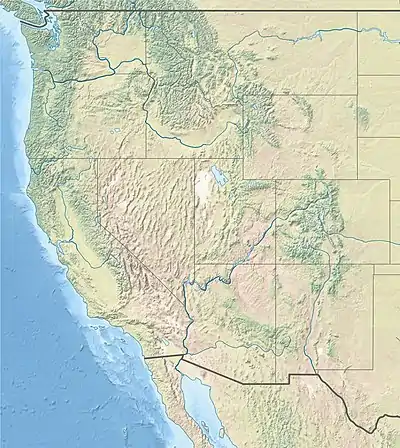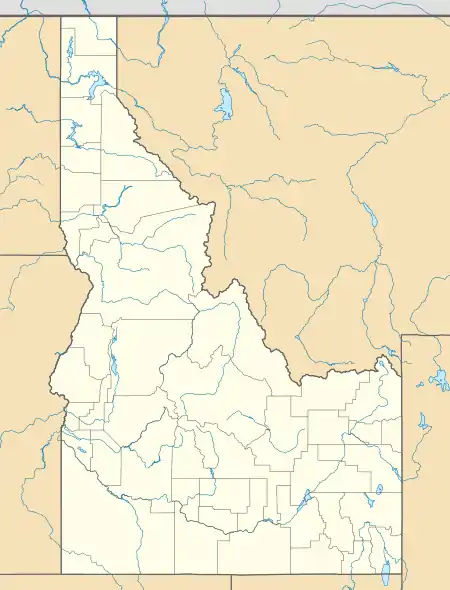2020 Central Idaho earthquake
The 2020 Central Idaho Earthquake occurred on March 31, 2020, at 5:52 PM MDT in the Western United States, near Ruffneck Peak in the Sawtooth Mountains in Central Idaho, 72 miles (116 km) northeast of Boise, Idaho and 19 miles (31 km) northwest of Stanley, Idaho.[2][3][4]
 Challis Boise  Challis Boise | |
| UTC time | 2020-03-31 23:52:31 |
|---|---|
| ISC event | 617825623 |
| USGS-ANSS | ComCat |
| Local date | March 31, 2020 |
| Local time | 5:52:31 pm MDT |
| Duration | 10 Seconds[1] |
| Magnitude | 6.5 Mw |
| Depth | 14.5 km (9.0 mi) |
| Epicenter | 44.460°N 115.136°W |
| Type | Strike-slip |
| Areas affected | Idaho, United States |
| Max. intensity | VII (Very strong) |
| Landslides | Multiple |
| Foreshocks | Mw 2.2 |
| Casualties | 0 |
Tectonic setting
Parts of central and eastern Idaho lie within the northern part of the Intermountain Seismic Belt (ISB). This area of relatively intense seismicity runs roughly north–south from northwestern Arizona, through Utah, Idaho, and Wyoming, before dying out in northwestern Montana.[5] The ISB is characterized mainly by normal faulting of late Quaternary age, indicating active extensional tectonics, as recognized throughout the Basin and Range province to the south. Some historical earthquakes show evidence of strike-slip faulting such as the two largest earthquakes of the 1935 Helena earthquake sequence.[6][7]
Historical seismicity
Historical seismicity in the immediate vicinity of the March 31 earthquake is sparse; no earthquakes of M5+ have occurred within 50 km of this event over the past 50 years, and the most notable historic seismicity in the region occurred about 100 km to the east on the Lost River fault zone. This was the site of the M6.9 Borah Peak earthquake (October 28, 1983), which was followed by five other M 5+ events over the following year, and most recently a M5.0 earthquake in January 2015, about 60 km to the east of the event.[2] The March 31 earthquake was reported to be felt in six different states.[8]
Earthquake
The shock measured 6.5 on the moment magnitude scale and had a maximum Mercalli intensity of VII (Very strong). The observed focal mechanism is consistent with movement on a strike-slip fault. The solution found suggests either right lateral faulting on a fault trending west–east or left-lateral faulting on a fault trending north–south. Analysis of seismic waveforms supports left-lateral slip on a fault plane with a strike of 172°, dipping steeply to the west.[9] The earthquake was about 16 km north of the northern tip of the Sawtooth Fault, a 60-km-long east-dipping normal fault that extends along the eastern base of the Sawtooth Range.[2] There is currently no evidence of any surface rupture.[1]
Left lateral strike-slip movement on a north–south trending fault came as a surprise as it does not seem to match the known orientation of the regional stress field. The north–south orientation is supported by InSAR data and the distribution of aftershocks. The fault responsible was not previously known and lacks any obvious topographic expression.[1]
The quake had numerous aftershocks, including one with a magnitude of 4.8 on April 1, and another with a magnitude of 4.0 on April 3.[10] As of April 8, 2020, there had been ~300 aftershocks of 2.5 magnitude or greater.[11][12] Aftershocks continued to rock the area through September.[13]
Damage
Significant structural cracks were found on the Bridge services building and on the Custer County courthouse in Challis, Idaho.[14]
The Idaho Geological Survey was prevented from doing a ground survey inspection of the impacted region due to both heavy snowfall and a statewide travel ban that was in effect due to the COVID-19 pandemic. Two overflights revealed some avalanches that may have been caused as well as a few landslides across minor highways. The Idaho Geological Survey stated they may not be able to do a more complete inspection until Summer of 2020.[1]
See also
References
- "Stanley Earthquake". Idaho Geological Survey. Retrieved April 20, 2020.
- ANSS. "Idaho 2020: M 6.5 - 72km W of Challis, Idaho". Comprehensive Catalog. U.S. Geological Survey. Retrieved March 31, 2020.
- Osborne, Hannah (April 1, 2020). "Strong Magnitude 6.5 Earthquake Hits Idaho for First Time in 50 Years, as Quakes Recorded in Yellowstone and Salt Lake City". Newsweek. Retrieved April 19, 2020.
- Boone, Rebecca (April 1, 2020). "Magnitude-6.5 Earthquake Rattles Idaho North of Boise". Time. Retrieved April 19, 2020.
- Wong, I.; Olig, S.; Dober, M.; Wright, D.; Nemser, E.; Lageson, D.; Silva, W.; Stickney, M.; Lemieux, M.; Anderson, L. (2004). "Earthquake ground shaking hazard maps for the state of Montana" (PDF). 13th World Conference on Earthquake Engineering Vancouver, B.C., Canada. Retrieved 11 July 2012.
- Thamke, J.N.; Reynolds, M.W. (2000). "Hydrology of Helena Area Bedrock, West-Central Montana, 1993–98 with a section on Geologic Setting and a Generalized Bedrock Geologic Map". U.S. Geological Survey Water-Resources Investigations Report 00-4212. USGS. p. 14. Retrieved 8 July 2012.
- Doser, D.I. (1989). "Source parameters of Montana earthquakes (1925–1964) and tectonic deformation in the northern Intermountain Seismic Belt". Bulletin of the Seismological Society of America. Seismological Society of America. 79 (1): 31–50. Retrieved 8 July 2012.
- "Magnitude 6.5 Earthquake Felt in Central Idaho". United States Geological Survey. March 31, 2020. Retrieved March 31, 2020.
- ANSS: Idaho 2020, Finite Fault (accessed April 28, 2020).
- "M 4.8 - 72km ESE of Cascade, Idaho". United States Geological Survey. Retrieved April 1, 2020.
- "Latest Earthquakes". earthquake.usgs.gov. Retrieved 2020-04-04.
- "Over 340 aftershocks reported in the two weeks after Idaho's 6.5 earthquake". KTVB. April 15, 2020. Retrieved April 19, 2020.
- "Why Idaho Hasn't Stopped Shaking Since March 31". news.yahoo.com. Retrieved July 8, 2020.
- Bustillo, Ximena (3 April 2020). "Earthquake aftershocks felt in Boise; Custer courthouse damaged; avalanches dot Sawtooths". Idaho Statesman. Retrieved 4 April 2020.